| Volume 2012, Issue 11 | February 28, 2012 |
|

Cal-Neva AFS Meeting:
March 28-31
Salmonid Restoration Federation Conference:
April 4-7
Pick and Gather at Riverdance Farms and Merced River Fair:
June 2-3
National Conference on Engineering & Ecohydrology for Fish Passage:
June 5-7
|
|
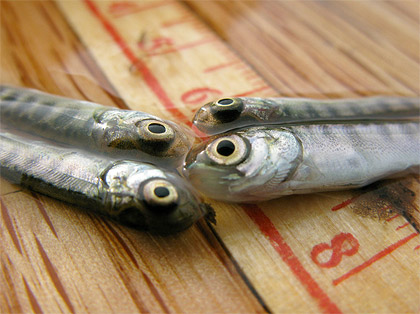
|
Key Highlights
February 6, 2012 - February 19, 2012
Calaveras River Juvenile Migration Monitoring continued at Shelton Road (RM 28) during the reporting period. A total of three O. mykiss were captured, increasing the season total to 71. One Chinook salmon fry was also captured, bringing the season total to one.
Stanislaus River Juvenile Migration Monitoring continued at Oakdale (RM 40) during the reporting period. A total of 1,974 Chinook salmon were captured, increasing the season total to 5,405. No O. mykiss were captured and the season total remains at 16. Information not available at time of this report for monitoring at Caswell State Park (RM 8).
Tuolumne River Juvenile Migration Monitoring continued at Waterford (RM 30) during the reporting period. A total of 496 Chinook salmon were captured, increasing the season total to 1,735. No O. mykiss were captured, and the season total remains at zero. Monitoring at Grayson (RM 5) continued during the reporting period. No Chinook salmon were captured and the season total remains at six. No O. mykiss were captured and the season total remains at zero.
Mokelumne River Juvenile Migration Monitoring continued at Vino Farms (RM 54) during the reporting period. A total of 4,056 Chinook salmon were captured, increasing the season total to 9,499. No O. mykiss were captured and the season total remains at five. Monitoring at Golf (RM 38) continued during the reporting period. A total of 310 Chinook salmon were captured, increasing the season total to 559. No O. mykiss were captured and the season total remains at five.
Stanislaus River Weir Monitoring continued during the reporting period. A total of three Chinook salmon passed upstream through the weir, increasing the season total to 817. Seven O. mykiss passed upstream through the weir, increasing the season total to 57.
Tuolumne River Weir Monitoring continued during the reporting period. A total of four Chinook salmon passed upstream through the weir, increasing the season total to 2,847. Two O. mykiss passed upstream through the weir, increasing the season total to nine.
San Joaquin River Conditions. San Joaquin River flow at Vernalis ranged from 1,582 cfs to 1,685 cfs. Daily average water temperature in the San Joaquin River ranged from 51.7°F to 55.2°F at Vernalis, and from 52.7°F to 57.4°F at Mossdale. Daily average dissolved oxygen (DO) in the San Joaquin River ranged from 9.5 mg/L to 10.4 mg/L at Mossdale, and from 8.9 mg/L to 9.4 mg/L in the deep-water ship channel (measured at Rough 'n Ready Island).
Delta Exports. Combined total exports (state and federal pumps) fluctuated during the reporting period, ranging from 2,101 cfs to 4,700 cfs.
|
|
2011/12 Calaveras River Juvenile Migration Monitoring
The Calaveras River rotary screw trap at Shelton Road (RM 28) sampled eight days between February 6 and February 19. A total of three O. mykiss were captured, 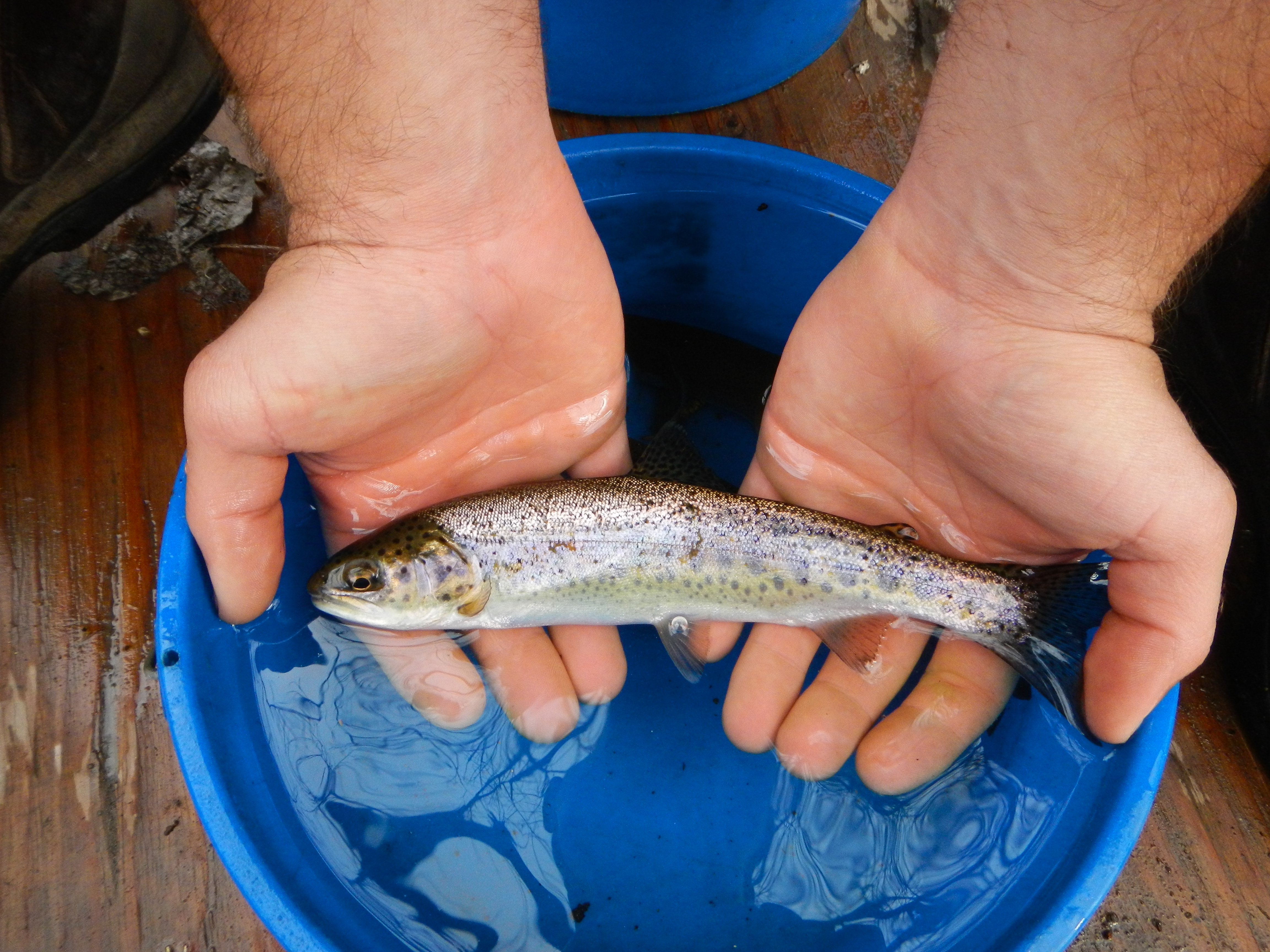 increasing the season total to 71. Daily catch ranged from zero to two individuals (Figure 1). Average forklengths and weights of O. mykiss are provided in Table 1. Two of the O. mykiss captured were Age 1+ (100-299 mm) smolts and one was an adult (>300 mm). increasing the season total to 71. Daily catch ranged from zero to two individuals (Figure 1). Average forklengths and weights of O. mykiss are provided in Table 1. Two of the O. mykiss captured were Age 1+ (100-299 mm) smolts and one was an adult (>300 mm).
One Chinook salmon fry (<50mm) was captured, bringing the season total to one.
Daily average combined flows from New Hogan Dam (NHG) and Cosgrove Creek (COS) fluctuated between 26 cfs and 37 cfs, and at Bellota (MRS) flows ranged from 0 cfs to 10 cfs (Figure 1).Instantaneous water temperatures recorded at the trap ranged from 46.2ºF to 50.3ºF, and turbidity ranged from 0.14 NTU to 1.40 NTU.
Table 1. Biosampling data for salmonids captured at Shelton Road (RM 28) between February 6 and February 19, 2012. Parenthesis indicates range.
 
Figure 1. Daily O. mykiss catch at Shelton Road in relation to Calaveras River flow recorded by New Hogan Dam (NHG) and Cosgrove Creek (COS) combined and recorded at Bellota (MRS) between October 15, 2011 and February 19, 2012.
|
2011/12 Stanislaus River Juvenile Migration Monitoring
 The Stanislaus River rotary screw trap at Oakdale (RM 40) sampled continuously between February 6 and February 19. A total of 1,974 Chinook salmon were captured, increasing the season total to 5,405. Daily catch ranged between 18 and 514 Chinook (Figure 2). Average forklengths and weights of all measured Chinook salmon are provided in Table 2. Most of the fish measured were fry (n=887), but parr (n=40) and smolt (n=17) were also observed. The Stanislaus River rotary screw trap at Oakdale (RM 40) sampled continuously between February 6 and February 19. A total of 1,974 Chinook salmon were captured, increasing the season total to 5,405. Daily catch ranged between 18 and 514 Chinook (Figure 2). Average forklengths and weights of all measured Chinook salmon are provided in Table 2. Most of the fish measured were fry (n=887), but parr (n=40) and smolt (n=17) were also observed.
No O. mykiss were captured and the season total remains at 16.
Daily average flows at Goodwin Dam (GDW) ranged from 402 cfs to 612 cfs, and at Ripon (RIP) ranged from 413 cfs to 570 cfs (Figure 2). Instantaneous water temperatures taken at the trap ranged from 46.4ºF to 50.0ºF, and turbidity ranged from 0.30 NTU to 2.19 NTU.
Table 2. Biosampling data for salmonids captured and measured at Oakdale (RM 40) between February 6 and February 19, 2012.
 Six trap efficiency experiments were conducted with naturally spawned juvenile Chinook salmon marked caudal fin green (CFG). The preliminary estimated capture efficiencies are provided in Table 3. Table 3. Trap efficiency tests conducted at Oakdale (RM 40) between February 6 and February 19, 2012.

Figure 2. Daily Chinook salmon catch at Oakdale and Stanislaus River flow recorded at Goodwin Dam (GDW) and Ripon (RIP) between January 1, 2012 and February 19, 2012.
Information not available at time of this report for monitoring at Caswell State Park (RM 8).
|
2012 Tuolumne River Juvenile Migration Monitoring
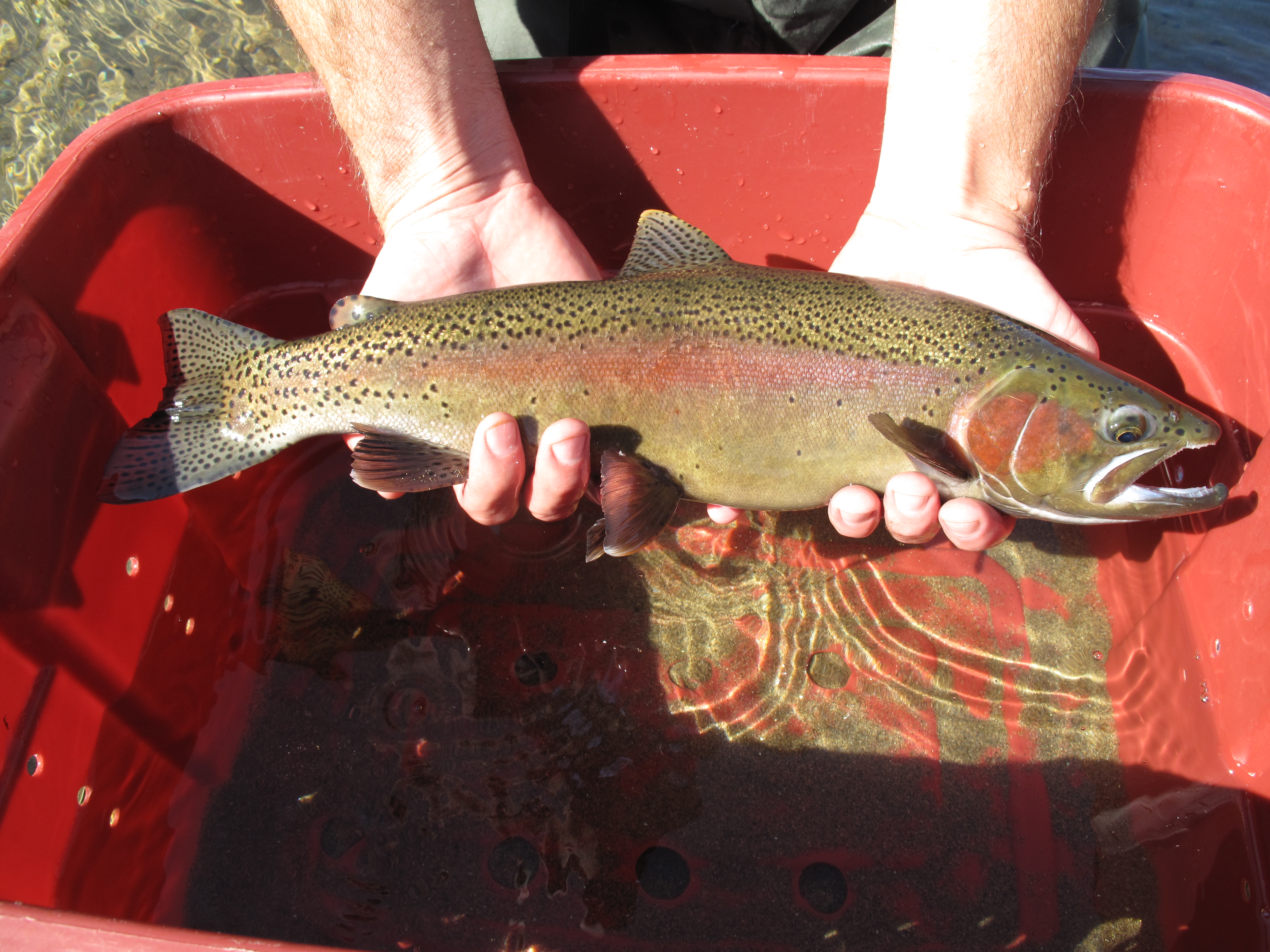 The Tuolumne River rotary screw trap at Waterford (RM 30) operated continuously between February 6 and February 19. A total of 496 juvenile Chinook salmon were captured, increasing the season total to 1,735. Daily catch ranged between four and 80 Chinook (Figure 5). Average forklengths and weights of all measured Chinook salmon are provided in Table 4. Most of the Chinook salmon captured were fry (n = 411), but parr (n = 34) and smolt (n=20) were also observed. The Tuolumne River rotary screw trap at Waterford (RM 30) operated continuously between February 6 and February 19. A total of 496 juvenile Chinook salmon were captured, increasing the season total to 1,735. Daily catch ranged between four and 80 Chinook (Figure 5). Average forklengths and weights of all measured Chinook salmon are provided in Table 4. Most of the Chinook salmon captured were fry (n = 411), but parr (n = 34) and smolt (n=20) were also observed.
No O. mykiss were captured, and the season total remains at zero.
Table 4. Biosampling data for Chinook salmon captured and measured at Waterford (RM 30) between February 6 and February 19, 2012. Parentheses indicate range. Daily average flows at La Grange (LGN) fluctuated between 337 cfs and 341 cfs (Figure 3). Instantaneous water temperatures taken at the trap ranged from 49.8ºF to 53.2ºF, and turbidity ranged from 0.74 NTU to 2.97 NTU. Four trap efficiency experiments were conducted with naturally spawned juvenile Chinook salmon marked caudal fin orange (CFO). The preliminary estimated capture efficiencies are provided in Table 5.
Table 5. Trap efficiency tests conducted at Waterford (RM 30) between February 6 and February 19, 2012.
  Figure 3. Daily Chinook salmon catch at Waterford (RM 30) and daily average Tuolumne River flows at La Grange (LGN) and Modesto (MOD) between December 1, 2011, and February 19, 2012. The Tuolumne River rotary screw traps at Grayson (RM 5) operated continuously between February 6 and February 19. No Chinook salmon were captured, and the season total remains at six (Figure 5). No O. mykiss were captured, and the season total remains at zero. Daily average flow at Modesto (MOD) was stable during the reporting period, ranging between 436 cfs and 453 cfs (Figure 4). Instantaneous water temperatures taken at the trap ranged from 50.5ºF to 55.7ºF, and turbidity ranged from 0.74 NTU to 4.81 NTU. No trap efficiency experiments were conducted.
Figure 4. Daily Chinook salmon catch at Grayson and Tuolumne River flow recorded at La Grange (LGN) and Modesto (MOD) between January 1 and February 19, 2012.
|
2011/12 Mokelumne River Juvenile Migration Monitoring
The Mokelumne River rotary screw trap at Vino Farms (RM 54) sampled intermittently between February 6 and February 19. A total of 4,056 juvenile Chinook salmon were captured, bringing the season total to 9,499. Daily catch ranged between 162 and 1,036 Chinook (Figure 5).
No O. mykiss were captured and the season total remains at five.
Daily average flows from Camanche Reservoir (CMN) ranged from 331 cfs to 335 cfs (Figure 5). Instantaneous water temperatures ranged between 47.1°F and 49.6°F, and instantaneous turbidity ranged between 1.55 NTU and 3.07 NTU.
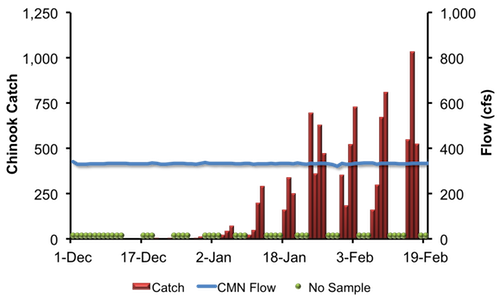 Figure 5. Daily juvenile Chinook catch at Vino Farms (RM 54) and daily averageMokelumne River flows at Camanche Reservoir (CMN) between December 1, 2011, and February 19, 2012. The Mokelumne River rotary screw trap at Golf (RM 38) sampled intermittently February 6 and February 19. A total of 310 juvenile Chinook salmon were captured, bringing the season total to 559. Daily catch ranged between 14 and 85 Chinook (Figure 6). Daily average flows recorded at Woodbridge (WBR) ranged from 221 cfs to 261 cfs (Figure 6). Instantaneous water temperatures ranged between 48.4°F and 51.8°F, and turbidity ranged between 2.89 NTU and 6.84 NTU.

Figure 6. Daily juvenile Chinook catch at Golf and Mokelumne River flow recorded at Woodbridge (WBR), between December 15, 2011, and February 19, 2012.
|
2011 Stanislaus River Weir Adult Migration Monitoring
The Stanislaus River Weir and Vaki Riverwatcher (RM 31) sampled continuously between February 6 and February 19. A total of three Chinook salmon were detected as they passed upstream of the weir, increasing the season total to 817. Daily passage ranged between 0 and one Chinook salmon.
Seven O. mykiss were detected passing upstream of the weir, increasing the season total to 57 (Table 7). Four of these fish were positively identified as hatchery origin (adipose fin clipped), one was positively identified as naturally spawned origin (adipose fin intact), and the disposition of the adipose fin could not be determined for two individuals. Of the 43 known origin individuals observed during the 2011-2012 season, 77% (n=33) were of hatchery origin, and 23% (n=10) were of naturally spawned origin.
Other fish passing upstream of the weir included five hardhead and 218 Sacramento suckers.
Daily average flows in the Stanislaus River at Goodwin Dam (GDW; RM 58) fluctuated between 402 cfs and 612 cfs (Figure 7). Flows at Ripon (RIP; RM 15) fluctuated between 414 cfs and 570 cfs. Note: flows downstream of Goodwin Dam may differ from dam releases due to irrigation, precipitation and other factors. Instantaneous water temperature measured at the weir ranged between 49.2˚F and 53.9˚F, and daily average water temperature at Ripon (RPN; RM 15) ranged between 50.0˚F and 53.1˚F (Figure 8). Instantaneous turbidity at the weir ranged between 0.77 NTU and 2.20 NTU (Figure 9). Instantaneous dissolved oxygen at the weir ranged between 11.18 mg/L and 12.33 mg/L, and daily average dissolved oxygen at Ripon (RPN; RM 15) ranged from 9.77 mg/L to 10.52 mg/L (Figure 10).
Table 6. Net passage counts for all species between January 23 and February 19, 2012 at the Stanislaus River Weir.  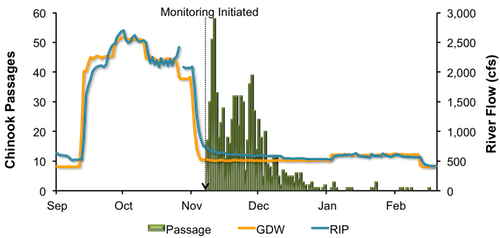 Figure 7. Daily upstream Chinook passage at the Stanislaus River weir in relation to daily average flows (cfs) recorded in the Stanislaus River at Goodwin (GDW) and Ripon (RIP), September 1, 2011 and February 19, 2012. Figure 8. Daily upstream Chinook passage recorded at the Stanislaus River weir in relation to instantaneous water temperature recorded at the weir, and daily average water temperature recorded in the Stanislaus River at Ripon (RPN), and in the San Joaquin River at Vernalis (VER), Mossdale (MSD) and Rough & Ready (RRI), September 1, 2011 and February 19, 2012.
Figure 9. Daily upstream Chinook passage at the Stanislaus River weir in relation to instantaneous turbidity recorded at the weir, September 1, 2011 and February 19, 2012.
Figure 10. Daily upstream Chinook passage at the Stanislaus River weir in relation to instantaneous dissolved oxygen recorded at the weir, and daily average dissolved oxygen recorded in the Stanislaus River at Ripon (RPN), and in the San Joaquin River at Mossdale (MSD) and Rough & Ready (RRI), September 1, 2011 and February 19, 2012.
|
2011 Tuolumne River Weir Adult Migration Monitoring
The Tuolumne River Weir and Vaki Riverwatcher (RM 22) sampled continuously between February 6 and February 19. A total of four Chinook salmon were detected as they passed upstream of the weir, increasing the season total to 2,847 (Table 8). Daily passage ranged between 0 and one Chinook salmon.
Two O. mykiss were detected passing upstream of the weir, bringing the season total to ten. One of the fish was positively identified as hatchery origin (adipose fin clipped) and one was positively identified as naturally spawned origin. Of the ten known origin individuals observed during the 2011-2012 season, 30% (n=3) were of hatchery origin, and 70% (n=7) were of naturally spawned origin.
Other fish passing upstream of the weir included two carp and 123 Sacramento suckers.
Daily average flows in the Tuolumne River ranged from 337 cfs to 341 cfs at La Grange (LGN; RM 50) and from 436 cfs to 453 cfs at Modesto (MOD; RM 17). Note: flows downstream of La Grange may be higher than dam releases due to accretion and Dry Creek inflows (Figure 11). Instantaneous water temperatures measured at the weir ranged from 51.9˚F and 55.5˚F and daily average water temperatures at Modesto ranged from 52.2˚F and 55.2˚F (Figure 12). Instantaneous turbidity at the weir ranged between 0.77 NTU and 2.24 NTU (Figure 13), and dissolved oxygen ranged between 10.92 mg/L and 12.15 mg/L (Figure 14).
Table 7. Net passage counts for all species between January 23 and February 19, 2012 at the Tuolumne River. 
Figure 11. Daily upstream Chinook passage at the Tuolumne River weir in relation to daily average flows (cfs) recorded in the Tuolumne River at La Grange (LGN) and Modesto (MOD), and in the San Joaquin River at Maze Road Bridge (MRB) and Vernalis (VNS), September 1, 2011 and February 19, 2012. 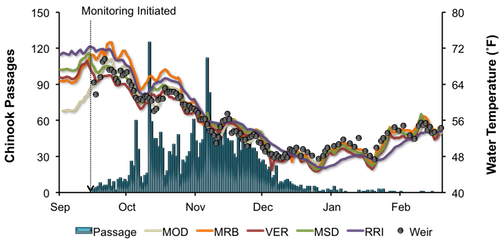
Figure 12. Daily upstream Chinook passage at the Tuolumne River weir in relation to instantaneous water temperature recorded at the weir, and daily average water temperature recorded in the Tuolumne River at Modesto (MOD) and in the San Joaquin River at Maze Road Bridge (MRB), Vernalis (VER), Mossdale (MSD) and Rough & Ready (RRI), September 1, 2011 and February 19, 2012. 
Figure 13. Daily upstream Chinook passage at the Tuolumne River weir in relation to instantaneous turbidity recorded at the weir, September 1, 2011 and February 19, 2012. 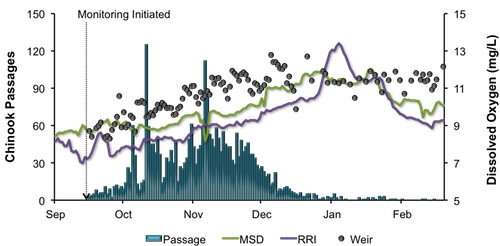
Figure 14. Daily upstream Chinook passage at the Tuolumne River weir in relation to instantaneous dissolved oxygen recorded at the weir, and daily average dissolved oxygen recorded in the San Joaquin River at Mossdale (MSD) and Rough & Ready (RRI), September 1, 2011 and February 19, 2012.
|
San Joaquin River Conditions
During the reporting period, flow in the San Joaquin River at Vernalis ranged from 1,582 cfs to 1,685 cfs (Figure 16). Daily average water temperature in the San Joaquin River ranged from 51.7°F to 55.2°F at Vernalis, from 52.7°F to 57.4°F at Mossdale, and from 52.0°F to 53.5°F at Rough 'n Ready Island (Figure 17). Daily average dissolved oxygen (DO) in the San Joaquin River fluctuated from 9.5 mg/L to 10.4 mg/L at Mossdale, and from 8.9 mg/L to 9.4 mg/L in the deep-water ship channel (measured at Rough 'n Ready Island; Figure 18).
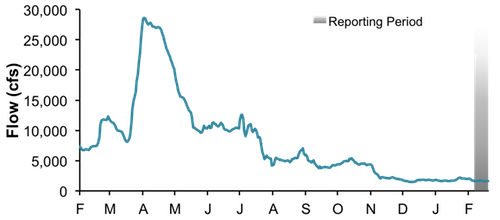
Figure 16. San Joaquin River flow at Vernalis from February 1, 2011, through February 19, 2012.
Figure 17. San Joaquin River daily average water temperature at Vernalis, Mossdale, and Rough 'n Ready from February 1, 2011, through February 19, 2012.
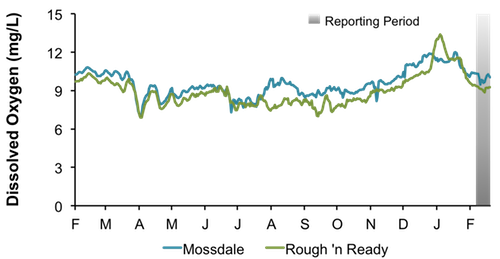
Figure 18. San Joaquin River daily average dissolved oxygen at Mossdale and Rough 'n Ready, from February 1, 2011, through February 19, 2012.
|
Delta ExportsMean daily pumping at the C.W. Jones Pumping Plant (federal pumps previously known as Tracy Pumping Plant) ranged from 998 cfs to 2,526 cfs (Figure 19). Mean daily pumping at the Harvey O. Banks Pumping Plant (state pumps) ranged from 1,101 cfs to 2,669 cfs. Combined total exports (state and federal pumps) fluctuated during this reporting period, ranging from 2,101 cfs to 4,700 cfs.
Figure 19. Daily exports at the state and federal pumping stations from February 1, 2011, through February 19, 2012.
|
|
|
|
|
|
|